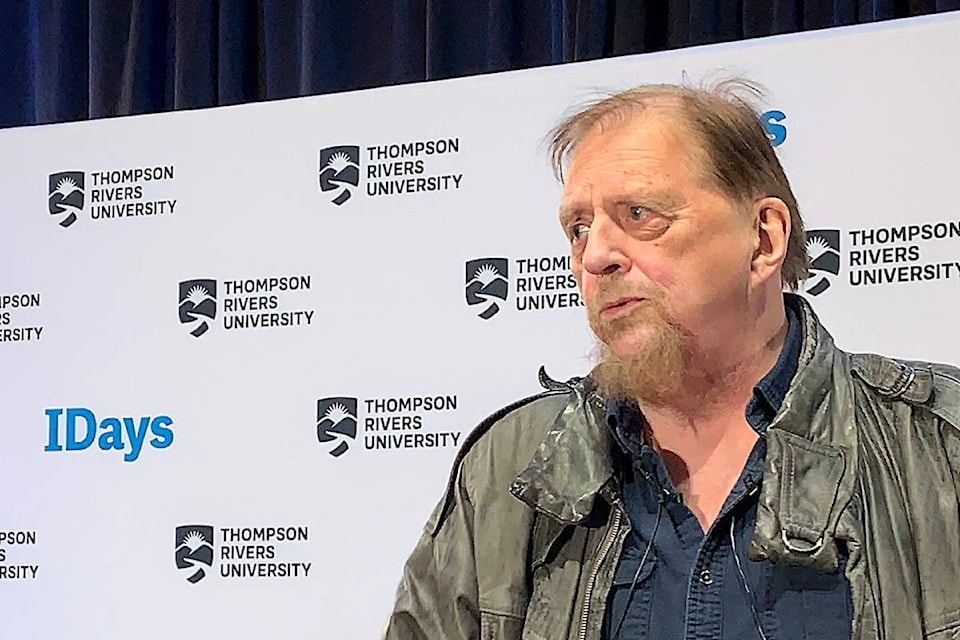By Keith McNeill
Will human civilization survive the climate crisis? Gwynne Dyer is not optimistic.
On the other hand, he is more optimistic now than he was five years ago – and much more optimistic than he was 10 years ago.
The Newfoundland-born author was speaking at Thompson Rivers University on Thursday evening, March 12, as part of the university’s IDays program.
About 200 people attended, including a few with connections to the North Thompson Valley.
One difference between today and five or 10 years ago is the attitudes and knowledge of young people, Dyer said.
“I almost never encounter deniers when I visit schools,” he said.
The Paris Agreement of 2016 committed to keeping the increase in global average temperature to well below 2ºC above pre-industrial levels.
“What would happen at 2ºC that we cannot allow to happen?” he asked. “Let’s talk specifics.”
The answer is feedbacks or tipping points. There are three main ones.
The first is that we are losing the sea ice on the Arctic Ocean.
Until 25 or 30 years ago the Arctic Ocean typically had about 10 million sq. km. of ice in winter and about seven million in summer.
During three of the past five summers, the summer sea ice has totalled only three to four million sq. km. – about half of what it formerly was.
Ice scientists predict that within 10 years the Arctic Ocean will be pretty well ice-free by the end of the summers. Not too long after that, it will be ice-free in winter as well.
This is important because ice is white and reflects sunlight, keeping the seawater and the planet cool. Open water, on the other hand, is dark and absorbs sunlight, making the seawater warmer and changing global weather patterns.
“I suspect it’s too late to do anything about that,” Dyer said.
Tipping point number two is melting permafrost.
There is a 10 million sq. km. ring of permanently frozen ground around the Arctic Ocean, he said.
About one-third of that ground is frozen organic matter. When it melts, as it has started to do in some areas, it will release huge amounts of CO2 and methane into the atmosphere.
Methane is many times more powerful as a greenhouse gas than CO2. Fortunately, it only lasts a few years in the atmosphere as compared to centuries for CO2.
Apparently youngsters living near Yellowknife amuse themselves by throwing lighted matches onto melt ponds. About one pond in four will explode because of the methane being released. Some burn all summer once lit.
The warming World Ocean is tipping point three.
“It’s the warm beer principle,” said Dyer. “Warm beer goes flat because warmer water holds less dissolved gases than cold water.”
At present, about one-third of the CO2 we release through burning fossil fuels is absorbed into the oceans.
That will change as the oceans warm. In fact, there is evidence that the rate of absorption is already slowing.
“We are getting close to the crossover point where the oceans start releasing more CO2 than they absorb,” he warned.
In addition, the warming water threatens the release of huge amounts of clathrate hydrates – methane that has been bonded at low temperatures with water molecules under the seafloor.
“Right now we can control things,” Dyer said. “We used canals for about 50 years and then stopped using them and started using railroads. We used railroads for another 50 years and then switched to roads and highways.”
“That shows we can stop using fossil fuels. We can do this but it’s a big ask … and we have to stop fast.”
If we trigger feedbacks then there would be no chance of the global cooperation we would need to reduce fossil fuel use.
“Is there a Plan B?” he asked.
If we cannot control fossil fuel use in the dramatic fashion that’s needed then we almost certainly will need to use geo-engineering, he said. There are various proposals.
One of the simplest and cheapest would involve spraying sulphur dioxide into the stratosphere. We know it would reduce the planet’s temperature because we have seen that happen after major volcanic eruptions.
About a dozen large airplanes flying three missions per day could release enough SO2 in six months to pretty well eliminate climate change – for a couple of years.
Cost would be from $2 billion to $10 billion.
It would be so cheap that there is a danger that nations greatly threatened by climate change, such as Bangladesh, might choose to go ahead on their own without approval from the world community.
Other proposals include extracting CO2 from the atmosphere and combining it with hydrogen to create an artificial liquid fuel similar to gasoline.
“This is the final exam,” said Dyer. “We might be smart enough to get through this … we shall see, shan’t we?”
